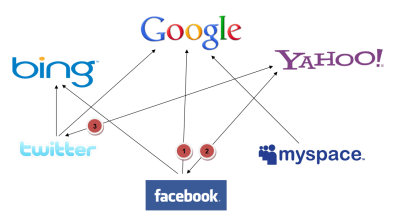
Adding real-time search and social search to the mix in the search engine world has created a number of new opportunities for marketers that want to do a better job of reaching customers. With new data sharing announcements happening fairly regularly, it can paint an interesting picture when you lay out the relationships between major social networks and search engines. It’s not unlike the search engine relationship chart from Bruce Clay I remember from several years ago documenting the relationships between Inktomi, Yahoo, Lycos, Alta Vista, Excite, HotBot, Direct Hit/Teoma, Northern Light and even Google. Not many of those are still around.
As the diagram above illustrates, the major data sharing for real-time search is between the social sites Twitter and Facebook and the major search engines Google, Yahoo and Bing. To be more specific:

Yahoo announced yesterday that they would significantly enhance their relationship with Facebook. According to Yahoo’s Jim Stoneham, VP Communities, “People who use Yahoo! and Facebook can now link their accounts to view and share updates with friends across both networks”.
![]()
Yahoo is expected to launch similar cross platform sharing functionality with Twitter and other social sites in the coming months according to MediaPost.
That kind of cross sharing relationship blurs the lines between social and search even more than the one–way integration of social media sites like Twitter and Facebook into Google and Bing search results.
When search engines used to syndicate search results from different sources or even each other, it was important to know how to get web pages included in those sources so they would appear in search results where customers were looking. As the major search engines update their data sources for real-time search and even socially influenced search, there’s an opportunity for marketers to understand how their participation on the social web can continue to provide signal and even content for the major search engines.
It doesn’t take much to see that some of the solutions for inclusion and earning top visibility are technical and related to publishing platforms, feeds and certain types of formats. Others are qualitative based on network size, type and topical focus. In the end, what matters is not just the changes search engines make to gain market share over each other, but the ways in which consumers respond in their information discovery, consumption and sharing behaviors.
While the effect of real-time search on current marketing programs isn’t anywhere as near as substantial as search marketing or even social media marketing, it’s an area that smart marketers would do well to monitor and experiment with.


